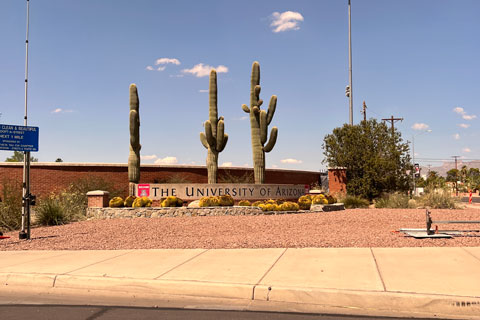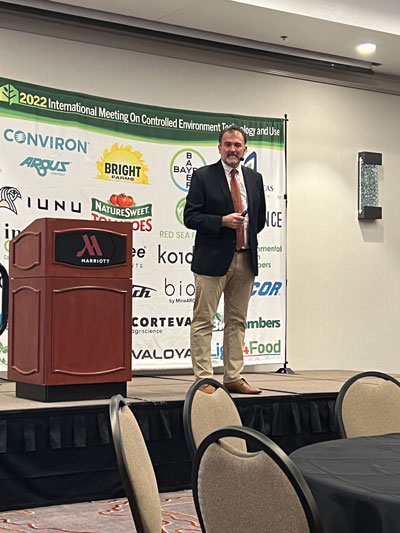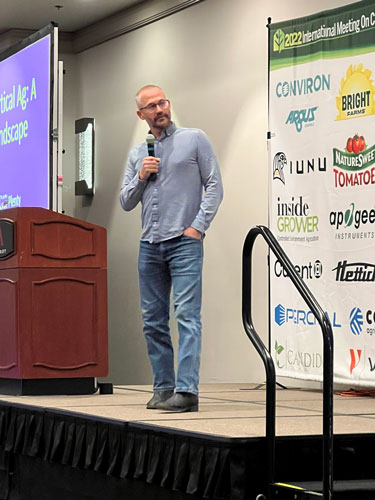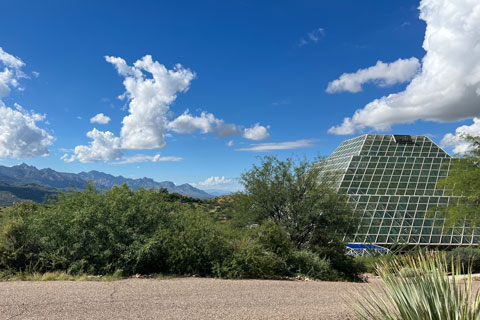11/1/2022
Meeting of the Minds
Jennifer Polanz

Originally slated for March 2020—before the world came to a standstill from COVID-19—some of the world’s brightest minds in controlled environment ag were finally able to gather in September at the Controlled Environment Technology and Use meeting.
The meeting of the North Central Extension and Research Activity, or NCERA-101, in collaboration with the UK Controlled Environment Users Group (UK-CEUG) and Australian Controlled Environment Working Group (ACEWG), was able to convene with an in-person conference hosted by the University of Arizona’s Controlled Environment Agriculture Center (UA-CEAC). This event brought 205 researchers, sponsor-allied companies, growers and consultants from 12 countries together to the campus in Tucson, Arizona, to talk CEA.
Amid the hot, but beautiful, backdrop of Tucson, the sessions highlighted new and advancing research on indoor lighting, smart environments, plant phenotyping and even novel applications like growing crops in space (something UA-CEAC has been heavily involved in for years).
I won’t be able to dive into everything discussed at the meeting, but I can provide an overview of some of the research presented there, as well as some of the viewpoints from panel discussions and key takeaways. Look for additional coverage online at inside-grower.com.
Lighting research
The lighting research sessions kicked off with the keynote from Leo Marcelis, the head of the Chair Group Horticulture and Product Physiology at Wageningen University in the Netherlands, one of the leading universities for indoor growing research in the world. He showed several studies, including:
• In an experiment on photoperiod of tomatoes in a greenhouse with high-pressure sodium (HPS) lights, adding three extra hours of light with the same intensity, from 12 to 15 hours, provided 20% more yield. Adding another three hours, from 15 to 18, increased yield another 8%. However, at 18 hours, the light was less efficient than at 15 hours. “What we can conclude from 15 to 18 hours, plants grow more if there is more light, but it is getting less efficient,” he said.
• Then he moved to light spectrum, highlighting studies that show adding far-red to red-blue can result in more elongation, more expansion and increase in growth rate, as well as improved fruiting in tomato plants. His study showed an increase of 45% in fruit dry mass with the addition of far-red lighting. In lettuce, adding far-red produces more expansion of the leaves, more interception of light and more growth. He did note that different cultivars and species could respond differently to changes in the light spectrum.
• Another experiment increased the lighting intensity of a crop in the last six days to see what effect it can have. In lettuce, the impact of six days of around 500 µmol m-2 s-1 light intensity increased Vitamin C and carbohydrate content, as well as improved shelf life.
He ended his talk by saying dynamic lighting can change the crop, but quality has to be the main concern first and the other growing conditions have to be taken into account as well.
“We should not forget that there’s always interaction with other climatic conditions,” he says. “You can optimize the light, but if you want to have an optimal yield and optimal quality you should also optimize all those other factors.”
To continue the discussion of dynamic lighting, University of Georgia Professor Marc Van Iersel (and one of the founding forces behind the company Candidus, as well as the LAMP Project for lighting research) dove into whether or not fluctuation in lighting impacts crops, in this case leafy green lettuce. He, in fact, found fluctuations up to 80 to 320 µmol m-2 s-1 did not impact the lettuce, which he says “opens up a lot of opportunity for control.”
 Pictured: Murat Kacira, director of the Controlled Environment Agriculture Center (CEAC) at University of Arizona, welcomes attendees to the International NCERA-101 meeting.
Pictured: Murat Kacira, director of the Controlled Environment Agriculture Center (CEAC) at University of Arizona, welcomes attendees to the International NCERA-101 meeting.
For example, he noted growers could time lighting to when their variable electricity prices are more favorable, increasing efficiencies. However, extreme fluctuations (400 µmol m-2 s-1 to 0 µmol m-2 s-1) did impact lettuce growth.
He also talked about research on sunlight forecasting and improving lighting costs by predicting the solar radiation forecast. His research will continue to focus on this area for the near future.
There was so much more on the topic of lighting that I’ll continue to cover in other spaces of Inside Grower, so watch the newsletter and www.inside-grower.com for more.
More advancements in CEA tech
As greenhouse and vertical farm environments become more sophisticated, the opportunities and challenges continue to grow. Efren Fitz-Rodriguez, the head of the Agricultural Engineering Institute at Chapingo University in Mexico (and alum of the UA-CEAC), laid out the advances and the challenges during his session, which highlighted the Internet of Things, or IoT, that is the ability to wirelessly control all aspects of the environment.
He called this Smart Agriculture, which includes everything from wireless sensors for data gathering and integration, machine visioning for mapping yield and forecasting, and automation. The opportunities include improved yield, reduced use of resources resulting in reduced environmental impact and better-quality crops.
However, there are drawbacks and challenges, he said. Those include difficulty first with connectivity (not everyone has strong wireless capabilities in their location), as well as increased costs, issues with security and subjective measurements of crop health that can impact data collection and analyzation. He also mentions the need for high computational power and storage, and the need for universal platforms that are not crop specific.
To continue the discussion of advanced technology, Peter Ling, associate professor in the Department of Food, Agricultural and Biological Engineering at The Ohio State University, took a look at high-tech sensing options like LIDAR, or Light Detection and Ranging, which can be used for plant canopy density measurement to provide more accuracy for irrigation and controls. He showed how they used LIDAR technology to create a precision variable rate sprayer to only spray where the plants are located, saving water and inputs.
Peter also talked about using drones for greenhouse crop monitoring, but cautioned that natural airflow can cause some stability issues that they haven’t been able to fully solve yet.
Continued CEA challenges
Nadia Sabeh, better known to many in the industry as Dr. Greenhouse (and another alum of UA-CEAC), is an HVAC and climate management expert, and highlighted a few ways CEA still has some work to do to gain efficiencies. She noted there are no HVAC systems designed specifically for greenhouse or indoor crop production—all of the existing models were created for other industries. The typical HVAC system, which is energy-intensive (particularly in extreme weather), experiences about 25% leakage, she said. She also noted growers are often oversizing their HVAC systems, particularly on the cannabis side of the industry.
“People are really scared of under-dehumidifying their rooms and having Botrytis and powdery mildew, and having condensation and mold issues. The other thing is, as HVAC engineers, we always design for the peak flow,” she said, adding that’s when lights are at their most intense and plants are transpiring, requiring more environmental control.
 Pictured: Nate Storey of the vertical farm Plenty talks about the challenges and opportunities involved in indoor growing.
Pictured: Nate Storey of the vertical farm Plenty talks about the challenges and opportunities involved in indoor growing.
But in other circumstances that design can result in over-dehumidification and over-cooling. Also, oversized equipment can constantly cycle on and off, wearing it down faster and pulling more power. She recommended choosing equipment with variable speeds and multiple stages.
In a panel session on the economic viability of indoor agriculture, Simone Valle de Souza, assistant professor of Agricultural, Food and Resource Economics at Michigan State University, noted the need for more data (more on that in a minute) to compare operational efficiencies for everything that happens in the indoor setting, something that will help drive CEA toward cost parity with field-grown products. However, she said during a later part of the panel that there are still niche opportunities now for better-quality products at premium prices that can only be grown indoors.
A call for transparency
As I alluded to earlier, more than one speaker noted the need for more transparency in CEA production to be able to measure efficiencies accurately, as well as standardized measurement systems in multiple areas. Nadia expressed the need for more real-world data from growers; currently most of the data used in research related to energy use is from models.
“You growers, we need data, and there’s a lot of reasons we need data,” she said. “One is because we need some consistent metrics we can all live by.”
She noted that while her team conducted a 105-page energy review, they found more than 15 different metrics reported for energy use.
“There are many energy efficiency and sustainability measures that exist, but really we just need more transparency and cooperation from CEA operators to understand what are industry standards, (and) what are best and cutting-edge practices because we don’t want you to all get overregulated because they think that something is standard when, really, it is cutting edge.”
Simone called for standards to measure key performance indicators (KPIs) for everything from operational efficiency related to labor to farm structure and environmental systems. It will be those measurements that help improve efficiencies to become more competitive. And Jenn Frymark, a UA-CEAC alum and chief greenhouse officer at Gotham Greens, talked extensively about standardized reporting that measures environmental impact for sustainability reporting.
Meanwhile, Nate Storey, co-founder and chief science officer at the vertical farm Plenty, explained a bit why it’s so difficult for operations to share information: many indoor growers are vying for the same funding—sometimes hundreds of millions of dollars—in a highly competitive space.
“It’s part of the game that we play in terms of raising money, but it doesn’t help researchers, it doesn’t help academic institutions and programs to understand what matters.”
He did add he’d like to see academic partnerships that have a structure around them to protect the commercial and institution partners.
Quick thoughts from growers
The meeting was pretty heavily focused on research and advances, but there was still time to hear from the growers, such as the aforementioned Nate from Plenty. They founded Plenty in 2014 with the objective of creating a local farm economy everywhere and achieving that with indoor farming that moved more of the variables (weather, pest pressure, etc.) under the grower’s control. Deploying technology was vital to getting the most out of the crop, both in yield and quality, at a quicker turnaround than field grown.
Martin Ruebelt, chief science officer at Nature Sweet, sat on a panel about indoor ag sustainability and talked about their most important asset: their people. He noted they’re 39% above industry average in pay, provide safety and educational training, and have a turnover rate of 0.9% (the industry average is 15% to 20%, he said).
Matt Lingard, vice president of agriculture and science at BrightFarms, participated in a panel on production quality and when asked what quality actually is, said at the end of the day, it’s about what the leaf looks like (they grow leafy greens) and if it’s something you want to eat.
“Is it a full, beautiful leaf, nice and crisp with no defects on it?” he said, adding quality itself doesn’t make the money, so you have to combine that with production standards, volume and consistency to delight not only end consumers, but also grocery customers. IG
More Resources
I couldn’t cover nearly all the research, tools and other information that came out of this meeting, so I tried to assemble a short list of resources to continue the educational journey:
• NCERA-101: controlledenvironments.org
• Project LAMP, a consortium of university researchers dedicated to helping growers reduce production costs: hortlamp.org
• Solar Forecasting: solargis.com/products/solar-power-forecast
• Greenhouse Lighting & Systems Engineering (GLASE): glase.org
• OptimIA, a consortium of researchers and industry collaborators focused on research and extension related to indoor ag: scri-optimia.org
 Biosphere 2
Biosphere 2
Tours were provided during the meeting and I hopped on the bus headed to Biosphere 2, that unique experiment that continues to provide insight today. Click the link to check it out. https://www.youtube.com/watch?v=OAOi65103j4